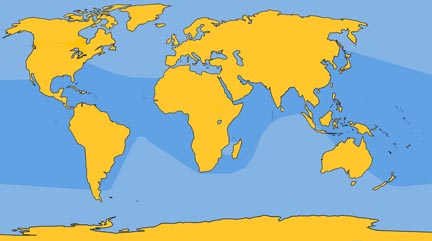
Family: Delphinidae
Genus: Stenella
Species: S. attenuata (Gray, 1846)
Taxonomic Note: There are many varieties of spotted dolphins found all around the world. Until more information is gathered on all of these populations, Stenella attenuata is commonly used to describe taxonomically all but the Atlantic species. However, Indian Ocean and certain Pacific Ocean populations are occasionally referred to as Stenella attenuata graffmani, a subspecies.
Spotted dolphins are gregarious animals, as are the Stenellas generally, and are often seen in the company of other dolphin species. Like their spinner dolphin relatives of the same region, pan-tropical spotted dolphins of the eastern tropical Pacific Ocean associate closely with schools of yellowfin tuna schools, an enigmatic relationship which has led to the incidental killing of hundreds of thousands of these dolphins during commercial purse seine tuna fishing operations. Also like the spinners, the spotted dolphins occur in many seas, with slight physical differences among herds. This has led to suggestions for a further subdivision of species, subspecies, and races, but as yet too little is known of these animals to warrant such classification.
Unlike the spinner dolphins, which may dive as deep as 200 ft (61 m) for food, the spotted dolphins appear to be surface feeders.
Physical Description: The body is long and thin with very well developed delphinid characteristics. They very much resemble Atlantic spotted dolphins in body form, except they are not a stocky.
Color: There are slight variations among herds. The basic description is steel gray dorsally from the beak and just above the eyes to and including the flukes, and from the beak to and encompassing the eyes. The flanks and ventral areas are gray. The flippers are steel gray with an extended stripe from the leading stripe from the leading margin to the rostrum. Normally, at least a portion of the tip of the rostrum is white, and in many cases the upper and lower lips are completely white. The dark parts of the body are covered with dense gray spots, and gray portions of the body are covered with lighter spots. In offshore populations, calves are purple-gray dorsally, white ventrally, with no spots. Juveniles become dark dorsally, light ventrally. Ventral spots appear with maturity, covering much of the body and often overlapping, showing a mottled coloration with light gray dorsal spots.
Fins and Flukes: The dorsal fin is falcate and can be either slightly rounded or pointed. The flippers are small and for the most part pointed, and very well defined. The flukes are small, pointed at the tips, with a small median notch.
Length and Weight: Pan-tropical spotted dolphins reach about 7 ft (2.1 m) and an estimated weight of 280 lb (127 kg).
Teeth: They have between 41 and 45 small, conical teeth in each side of the upper and lower jaws.
Feeding: Little is known of their feeding habits. Their diet includes squid and surface-dwelling fish such as flying fish.
Breathing and Diving: These dolphins exhibit a “porpoising” behavior (long, shallow leaps, clear of the water) as they swim.
Mating and Breeding: Calves are born at about 32 in (80 cm) after a gestation period of about 11 months. Lactation lasts 11 months. Sexual maturity in males is reached at between 6 and 8 years at 6.75 ft (2 m); in females at 6.5 ft (1.9 m). Females are believed to give birth every two years, but this may be more often than might be the case in normal circumstances because of the stress placed on the populations by tuna fishing and consequent dolphin mortality.
Herding: Herds of up to 3,000 to 4,000 have been observed, but the common herd is comprised of a hundred or less.
Distribution: These animals are found throughout the tropical regions of the Pacific Ocean. They are known to occur in the South China Sea and the waters around Japan, and as far south as Australia and New Zealand.
Migration: These animals appear to have complex migratory habits but we know very little about them.
Natural History Notes: Although not wary of boats, they seldom ride bow waves.








